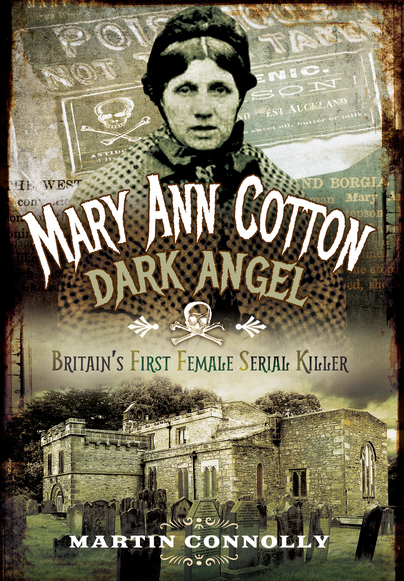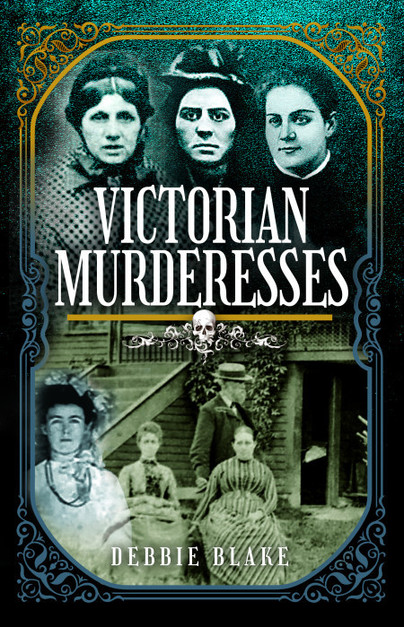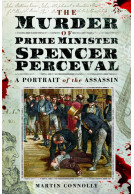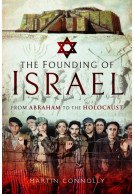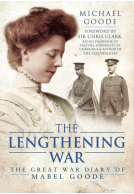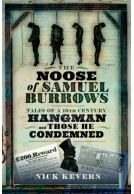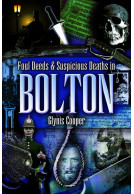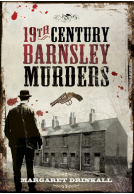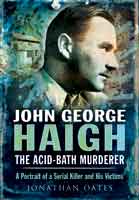Mary Ann Cotton - Dark Angel (Paperback)
Britain’s First Female Serial Killer
Imprint: Pen & Sword True Crime
Pages: 192
Illustrations: 32 images and maps
ISBN: 9781473876200
Published: 1st August 2016
Last Released: 30th March 2023
ITV drama, Dark Angel
Recommended as one of the Evening Standard's ‘Best biographies and memoirs to read in 2016’
Mary Ann Cotton's crimes were the subject of the 2016 ITV drama, Dark Angel, starring Joanne Froggatt.
(click here for international delivery rates)
Order within the next 9 hours, 3 minutes to get your order processed the next working day!
Need a currency converter? Check XE.com for live rates
| Other formats available | Price |
|---|---|
| Mary Ann Cotton - Dark Angel ePub (7.3 MB) Add to Basket | £6.99 |
| Mary Ann Cotton - Dark Angel Audiobook (794.7 MB) Add to Basket | £25.00 |
A female thief, with four husbands, a lover and, reportedly, over twelve children, is arrested and tried for the murder of her step-son in 1872, turning the small village of West Auckland in County Durham upside down. Other bodies are exhumed and when they are found to contain arsenic, she is suspected of their murder as well. The perpetrator, Mary Ann Cotton, was tried and found guilty and later hanged on 24 March 1873 in Durham Gaol. It is claimed she murdered over twenty people and was the first female serial killer in England.
With location photographs and a blow by blow account of the trial, this book challenges the claim that Mary Ann Cotton was the ‘The West Auckland Borgia’, a title given to her at the time. It sets out her life, trial, death and the aftermath and also questions the legal system used to convict her by looking at contemporary evidence from the time and offering another explanation for the deaths. The book also covers the lives of those left behind, including the daughter born to Mary Ann Cotton in Durham Gaol.
As featured in the article: The Teapots of Terror
The Advertiser (Durham)
Article: The teapots of terror: Wrapping up the 150th anniversary of serial killer Mary Ann Cotton with a song, a stool and a spook
The Northern Echo
Pen and Sword always publish interesting, and in this case, disturbing books. Chelton is a fascinating character, though I'm extremely glad I never met her. Connolly traces a thorough history and writes one of the best historical true crime books I've read for a while. It was also nice, well, not nice, but it was a change from the usual American tales. I'd be curious to read more books on female serial killers because in a patriarchal world, they're believed to be few in number. I guess we'll never really know.
NetGalley, Brooke Sheldon
As featured on...
Lil's Vintage World, YouTube
Martin Connolly has made this non-fictional account of Mary Ann’s Cotton come to life. He is to be commended for a fascinating and very engrossing read.
Crime Review
Read the full review here.
As featured on Amazon.
Amazon reviewer
Oof, extremely Gothic dour noir. If you're a fan of The Knick and want to swim across the Pond for some overcast storytelling and late Victorian physik, this is definitely the true, real-life, murder most foul story you must read, posthaste.
GoodReads, K Fisher
An informative book about British serial killer Mary Ann Cotton, who killed for money.
NetGalley, reviewed by Bonnie Kernene
Martin Connolly is a researcher and writer who felt compelled to write the full story of Mary Ann Cotton after living in the village where she is thought to have carried out many of her murders and hearing the folklore.
Crime Traveller, reviewed by Fiona Guy
In his book Mary Ann Cotton: Dark Angel he has certainly done that, including comprehensive research unearthing timelines, photographs, and excerpts from trial transcripts, personal letters and newspaper articles of the time. It is a complex in-depth book on a complicated case spanning decades and impacting the lives of many.
To read the rest of this interesting and extensive review, Click me
As featured in.
Evening Standard
As featured on [linkhttp://betweenthebookends.recinella.dk/sample-page/]Between the Bookends.[/link]
Between The Bookends Blog
As featured on The Quiet Knitter.
The Quiet Knitter Blog
As featured on Rosie Writes Blog
Rosie Writes Blog
As a look into the times Mary Ann Cotton lived, how her life may have been, and whether or not she's truly guilty of everything she's accused of, this book is a very good examination of that and doesn't condemn her for things she couldn't have possibly done or been involved in, even if she was believed to have been guilty during her life because people were swept up in excitement of her case and trial.
NetGalley, reviewed by Jenn Waterman
I found this book so intersting. Looking at Mary Ann Cotton today, I feel she was railroaded at her trial. I can't say if she is guilty or not but there is definitely reasonable doubt. Martin Connolly did a great job putting the story on paper so the reader could understand it. Although I found some of the original letters hard to read at times, I was able to figure them out and it added to the authenticity of the book. Overall I really liked it.
NetGalley, reviewed by Jennifer Coleman
With a new drama series being aired later this year (2016) about Mary Ann Cotton, I was intrigued to read this new edition of a book about Britain’s first female serial killer, by local historian Martin Connolly. Mary Ann Robson was born in 1932, to Methodist parents in a mining community. It would be some time before she became Mary Ann Cotton and, in her life, she would have a number of bewildering name changes, and husbands, over the years.
NetGalley, reviewed by Susan Riaz
Connolly is obviously a great source of local history and he has done his research in tracking Mary Ann’s progress through various jobs, marriages and the births – and deaths – of her many children. He is scrupulously fair in his reporting and so Mary Ann is certainly not painted in a bad light, and her guilt is not assumed.
Thoroughly researched and meticulously presented one can view birth records, death certificates, and census records of Mary Cotton's various living arrangements. Author Martin Connolly makes the true crime story of "Mary Cotton-Dark Angel" come to life. The reader experiences the 1870's arrest, incarceration and murder trial of Mary Cotton. A fascinating, totally engrossing read.
NetGalley, reviewed by Fran Eichenauer
I became interested in Mary Ann Cotton after hearing an episode about her on the Things You Missed In History podcast. First off, dang that woman gave birth to a lot of children! How come no one has considered postpartum depression in their modern revisits to the crimes? Well, that is assuming that she committed them. Mr. Connolly does an excellent job of questioning whether she should have been convicted.
NetGalley, reviewed by Susan Berg
I have to confess to being interested in this story on several different levels. Female serial killers are a rare beast so it is always interesting to find out a bit more about what made her tick and to speculate on why she set out on the path that she did. I also find it fascinating from a social history point of view as well. The mining community that she grew up in also housed a few of my husband’s ancestors. It would be interesting to know what they had thought about the celebrity in their midst.
NetGalley, reviewed by Net Ambler
The writing style will be fairly familiar to anyone who has ever done any family history research. Connolly has opted for a factual trip through the official documentation that proves various events in Mary Ann’s life. Beautifully illustrated by photos and maps of the local area he includes copies of local census entries and birth marriage and death records from the local Methodist churches. I originally had a digital copy of the book as my review copy from the publisher but ended up buying the printed version because of these superb photos and illustrations.
Connolly does take a very fair approach to the story refusing to speculate on what might have happened – leaving much of that to the excerpts from local newspapers etc. The inclusion of some of these sensationalist reports is interesting and gives you an idea of what Mary Ann was up against in her attempt to defend herself.
This was a time with high infant mortality and outbreaks of typhoid and cholera were frequent as well as the childhood diseases like measles and chicken pox. Any family history research in this area and at this time will reveal high numbers of children not making it to adulthood although in Mary Ann’s case it is particularly damning. A female thief with four husbands, a lover and over twelve children she was only arrested after the death of her step son. After this accusation other bodies were exhumed and the case against her began to build.
It is a fascinating story of the English legal system in the nineteenth century and indeed the tabloid style newspaper coverage that was clamouring for her head long before any conviction. This is a riveting read and one that will leave you with as many questions as there are answers.
Timed to coincide with the launch of ITV's latest drama “Dark Angel” this publication reports the life of Mary Ann Cotton, a convicted serial killer in England in the 1800s.
NetGalley, reviewed by Kate Noble
I've long held a fascination with Mary Ann Cotton, the psychology behind serial killers is an area of interest for many and indeed when you consider the number of convicted female serial killers it is genuinely intriguing.
Martin Connolly takes a methodical approach to recounting the history of this notorious figure, extensive research has been done and is presented openly and concisely through official documentation to ascertain a chronological timeline of the events. The inclusion of maps and photos of the local area allow the reader to physically see how and where Mary Ann lived. The census entries along with records of birth, marriage and deaths are also good additions of the research that is presented.
By also including reports from the local newspapers at the time of the events, Connolly presents the less factual side to the tale, however he remains staunchly impartial throughout, refusing to speculate and offering plausible explanations for events wherever possible.
An utterly fascinating read, well presented and one I will be purchasing the paperback copy of asap!
Thoroughly researched, this book explores the life and times of Mary Ann Cotton, thief, bigamist and possibly a murderer. The evidence is explored and a different explanation, based on the evidence given at her trial, is put forward; that her victim, her seven year old step-son, was in fact the victim of green wallpaper and
NetGalley, reviewed by Rosemarie Cawkwell
bug-killing soap used to wash the bed and walls. The exploration of the newspapers, and their influence on the outcome of the trial, and the formation of public opinion by sensational reporting was fascinating. Nothing changes. I enjoyed the social and judicial context provided in the narrative; understanding more of conditions in mining villages and the prejudices of small Victorian communities gives a better understanding of Mary Ann's behaviour.
Mary Ann Cotton was born in South Hetton, England in 1832 to a mining family. Her father, a bound miner, was contracted for one year receiving a deplorable family dwelling and meager wages. Upon contract completion, a mining family was displaced unless the breadwinner renewed for the subsequent year. Miners were forced to work in dangerous, unhealthy mines that might flood or collapse.This miserable existence was further complicated by rampant diseases such as typhoid, cholera and gastric flu. It was no surprise that Mary Ann's father died in a mine shaft accident and the family lost their income and housing.
Amazon reviewer
Leaving home at 16 years old, Mary secured a job as a nurse for mine owner Edward Potter. When the Potter children left for boarding school, Mary's taste of a rich lifestyle abruptly ended. Mary was determined, despite
her strict Methodist upbringing, to use her feminine wiles to find a rich husband. In this quest she married four times and had twelve or more children. Most suffered untimely deaths while Mary collected money from their life insurance policies. Were the deaths caused by disease, natural causes or the work of a murderer?
Thoroughly researched and meticulously presented one can view birth records, death certificates, and census records of Mary Cotton's various living arrangements. Author Martin Connolly makes the true crime story of "Mary Cotton-Dark Angel" come to life. The reader experiences the 1870's arrest, incarceration and murder trial of Mary Cotton. A fascinating, totally engrossing read.
5 STARS!
Timed to coincide with the launch of new ITV television drama “Dark Angel” this book chronicles the life and times of Mary Ann Cotton, the first convicted female serial killer in England. I have to confess to being interested in this story on several different levels. Female serial killers are a rare beast so it is always interesting to find out a bit more about what made her tick and to speculate on why she set out on the path that she did. I also find it fascinating from a social history point of view as well. The mining community that she grew up in also housed a few of my husband’s ancestors. It would be interesting to know what they had thought about the celebrity in their midst.
angelnetreviews.com
The writing style will be fairly familiar to anyone who has ever done any family history research. Connolly has opted for a factual trip through the official documentation that proves various events in Mary Ann’s life. Beautifully illustrated by photos and maps of the local area he includes copies of local census entries and birth marriage and death records from the local Methodist churches. I originally had a digital copy of the book as my review copy from the publisher but ended up buying the printed version because of these superb photos and illustrations.
Connolly does take a very fair approach to the story refusing to speculate on what might have happened – leaving much of that to the excerpts from local newspapers etc. The inclusion of some of these sensationalist reports is interesting and gives you an idea of what Mary Ann was up against in her attempt to defend herself.
This was a time with high infant mortality and outbreaks of typhoid and cholera were frequent as well as the childhood diseases like measles and chicken pox. Any family history research in this area and at this time will reveal high numbers of children not making it to adulthood although in Mary Ann’s case it is particularly damning. A female thief with four husbands, a lover and over twelve children she was only arrested after the death of her step son. After this accusation other bodies were exhumed and the case against her began to build.
It is a fascinating story of the English legal system in the nineteenth century and indeed the tabloid style newspaper coverage that was clamouring for her head long before any conviction. This is a riveting read and one that will leave you with as many questions as there are answers.
Featured as book of the month
Barnsley Chronicle
... Arsenic a deadly poison was used throughout the 19th century for a variety of purposes, easy to administer and for the most part, readily accessible. But how did so many deaths go unquestioned for so long? High infant mortality rates, rudimentary record keeping, and substandard nutrition of the poor all helped Mary Ann Cotton escape scrutiny. No doubt, Mary Ann who moved regularly from town to town also earned sympathy as a heartbroken mother and widow.
Robert Bartlett
The author has undertaken considerable research and questions previous thinking, always a difficult thing to do given so many changes to criminal investigation and the trial process as well as trying to get inside public attitudes of those far off days. It will be for the reader to consider if Cotton was guilty of the murder of Charles as convicted, and with all the additional knowledge now available and not known to the jury whether there is every likelihood she was a serial killer or a lady constantly beset by personal tragedy.
With a new drama series being aired later this year (2016) about Mary Ann Cotton, I was intrigued to read this new edition of a book about Britain’s first female serial killer, by local historian Martin Connolly. Mary Ann Robson was born in 1932, to Methodist parents in a mining community. It would be some time before she became Mary Ann Cotton and, in her life, she would have a number of bewildering name changes, and husbands, over the years.
Susan Riaz, Reviewer at DiscussItBookGroup
Connolly is obviously a great source of local history and he has done his research in tracking Mary Ann’s progress through various jobs, marriages and the births – and deaths – of her many children. He is scrupulously fair in his reporting and so Mary Ann is certainly not painted in a bad light, and her guilt is not assumed. One of the problems is that in the early section of the book, what we have are facts, dates and lists of births and deaths. I found it quite a frustrating read, trying to keep track of who was who; especially as Mary Ann had some very favoured names and several children were named Margaret or Robert.
Although it is good to keep an open mind, the number of deaths surrounding Mary Ann and, often her behaviour, is – to put it kindly – highly suspicious. Still, it is obvious that Connolly wants to be fair and so he is always giving other possible reasons for events. Still, the first half of this book is fairly dry and I will admit to struggling with this. There are, though, a number of news articles and reports from newspapers at the time, which help give a sense of place and time. I did not feel though that I knew Mary Ann very well, or what motivated her; aside from her desire for money and security, which, considering her relatively poor background is quite understandable.
If you can stay with this book until you get to the trial, then it certainly becomes more interesting. There are many of Mary Ann’s letters from prison (although these are typed and it would have been nice to have seen reproductions), plus a good examination of the evidence. This is a rather dry, if interesting, read, which would have been improved had the author managed to show us more of what made Mary Ann Cotton into the person she became, rather than just giving us the facts about her life. I received a copy of this book from the publisher, via NetGalley, for review.
Mary Ann Cotton was born in South Hetton, England in 1832 to a mining family. Her father, a bound miner, was contracted for one year receiving a deplorable family dwelling and meager wages. Upon contract completion, a mining family was displaced unless the breadwinner renewed for the subsequent year. Miners were forced to work in dangerous, unhealthy mines that might flood or collapse.This miserable existence was further complicated by rampant diseases such as typhoid, cholera and gastric flu. It was no surprise that Mary Ann's father died in a mine shaft accident and the family lost their income and housing.
Fran Eichener, Educator at William Floyd Schools
Leaving home at 16 years old, Mary secured a job as a nurse for mine owner Edward Potter. When the Potter children left for boarding school, Mary's taste of a rich lifestyle abruptly ended. Mary was determined, despite
her strict Methodist upbringing, to use her feminine wiles to find a rich husband. In this quest she married four times and had twelve or more children. Most suffered untimely deaths while Mary collected money from their life insurance policies. Were the deaths caused by disease, natural causes or the work of a murderer?
Thoroughly researched and meticulously presented one can view birth records, death certificates, and census records of Mary Cotton's various living arrangements. Author Martin Connolly makes the true crime story of "Mary Cotton-Dark Angel" come to life. The reader experiences the 1870's arrest, incarceration and murder trial of Mary Cotton. A fascinating, totally engrossing read.
Thank you Pen and Sword Publishing and Net Galley for the opportunity to read and review "Mary Ann Cotton-Dark Angel".
About Martin Connolly
Martin Connolly was born in Belfast in 1951. Married with seven grown up children, he has completed research in Psychology, Theology, Judaism and the Holocaust. He has published in magazines, and produced teaching materials in the three disciplines as well as writing on the origins of the conflict in Northern Ireland. His other books include A Potted History of West Auckland, and The Miners' Triumph: The First English World Cup Win in Football History.
Victorian Murderesses (Hardback)
The Victorian belief that women were the ‘weaker sex’ who were expected to devote themselves entirely to family life, made it almost inconceivable that they could ever be capable of committing murder. What drove a woman to murder her husband, lover or even her own child? Were they tragic, mad or just plain evil? Using various sources including court records, newspaper accounts and letters, this book explores some of the most notorious murder cases committed by seven women in nineteenth century Britain and America. It delves into each of the women’s lives, the circumstances that led to their…
By Debbie BlakeClick here to buy both titles for £34.99







